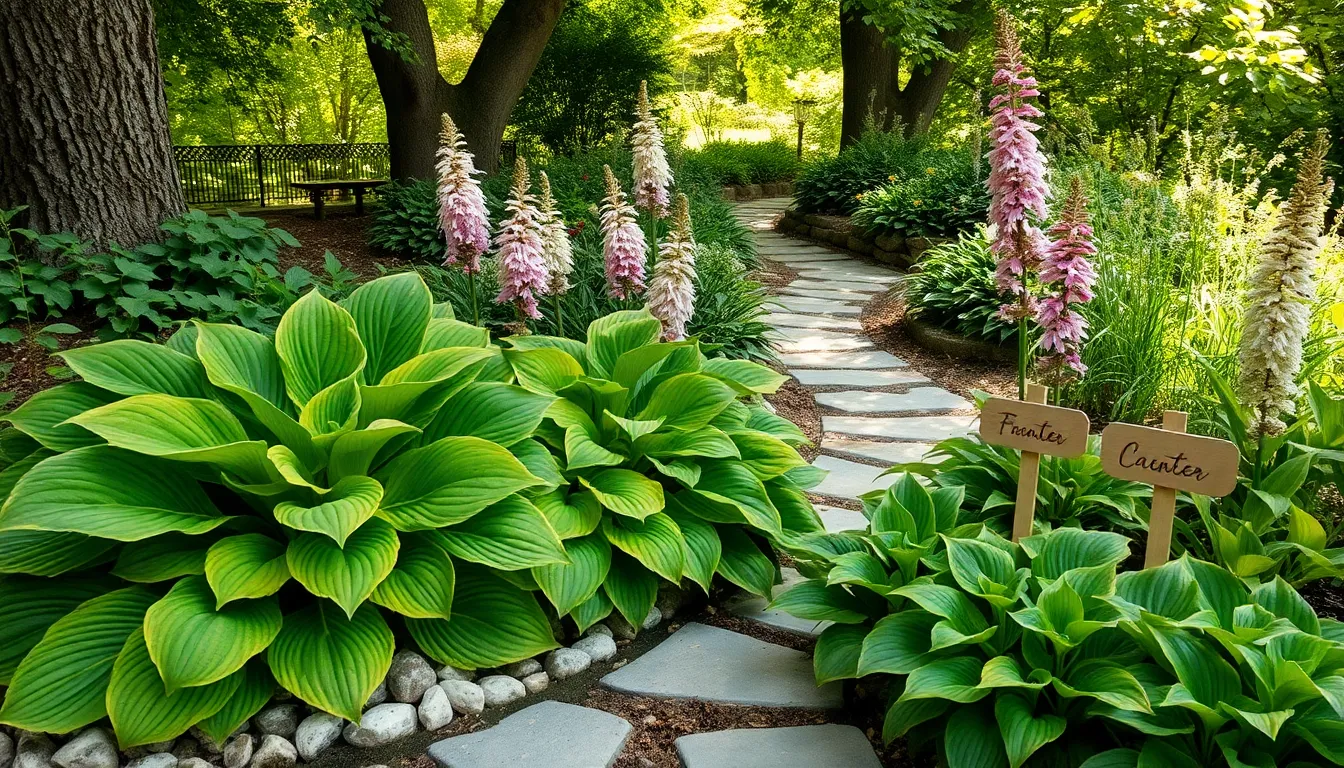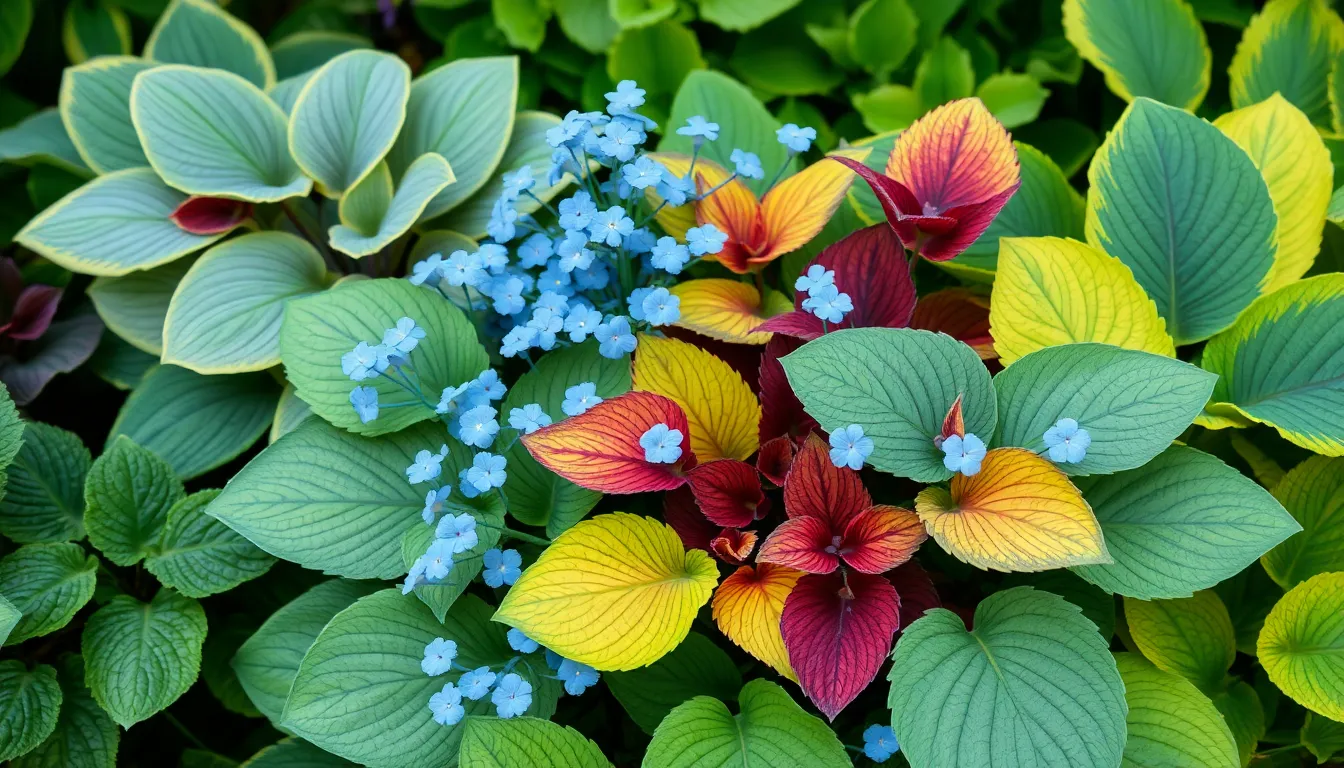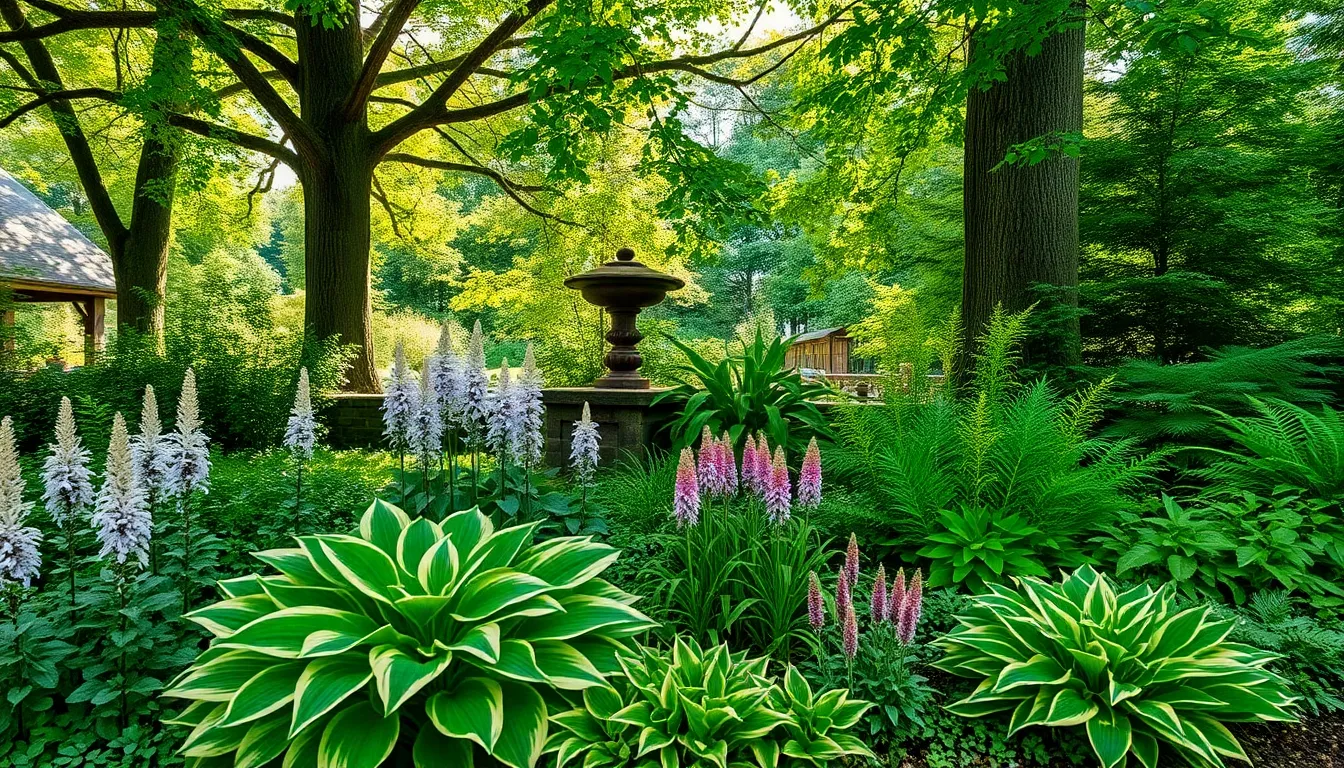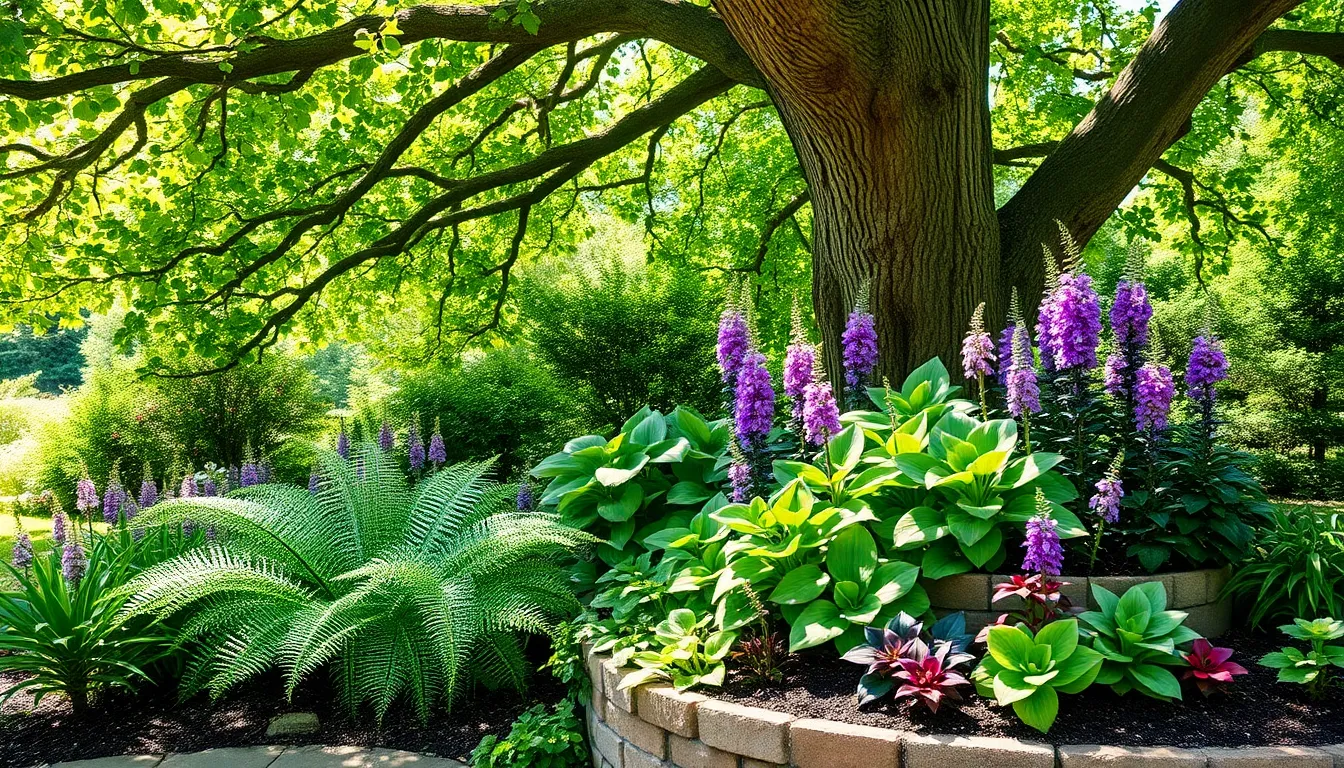When you think of gardening, sun-drenched landscapes might be the first images that spring to mind. However, let’s shine a light on a different realm of gardening that holds its own unique charm and challenges—the shade garden. Whether you’re a seasoned green thumb or just starting your gardening journey, embracing the shadows can open up a world of lush, diverse plantings. Shade gardens offer a serene sanctuary, filled with textures and hues that invite exploration and creativity.
Understanding the importance of shade gardening is key to unlocking the potential of those dimmer corners of your garden. A well-designed shade garden can become a cool, restful retreat during the heat of summer and a vibrant tapestry of greens and blossoms in the spring and fall. In this article, we’ll introduce you to 12 creative shade garden plants that will transform these often overlooked spaces. You’ll learn how to select the right plants that thrive without direct sunlight, discover tips for arranging them harmoniously, and get inspired by the stunning results you can achieve.
From ferns that cascade like waterfalls to flowers that glow like hidden gems, the possibilities are as vast as your imagination. As we delve into this topic, you’ll find that shade gardening is not just a workaround but a rewarding endeavor in its own right. This guide will equip you with the knowledge and confidence to cultivate a shade garden that’s as robust and lively as any sunlit plot. Embrace the art of shade gardening, where every plant is a testament to the beauty of resilience and adaptation.
Understanding Shade Garden Basics
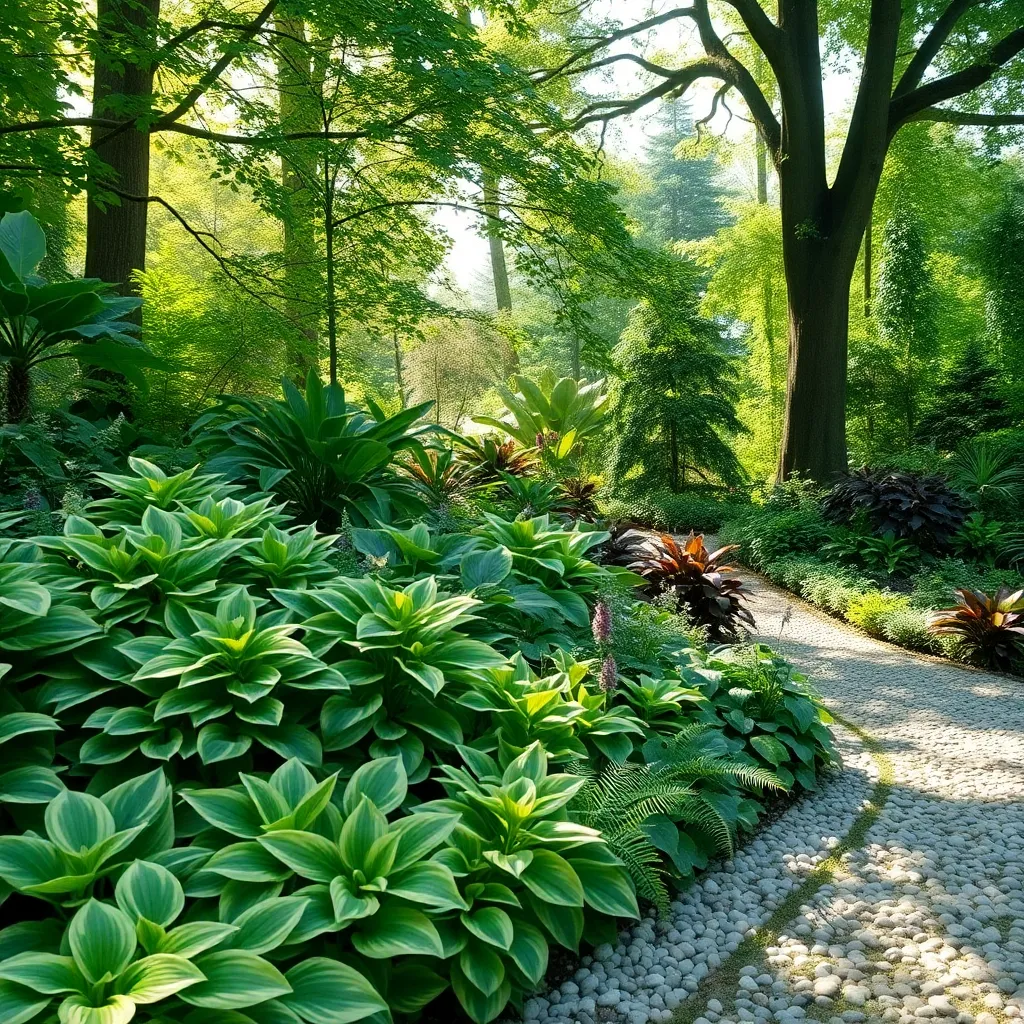
Understanding the basics of shade gardening is essential for creating a thriving garden in areas with limited sunlight. Shade gardens are ideal for locations that receive less than four hours of direct sunlight per day, such as under trees or along the north side of buildings.
Begin by assessing the type of shade your garden receives, as this will influence plant selection. Deep shade, partial shade, and dappled shade each offer different growing conditions, requiring plants that are specifically suited to those environments.
Soil quality is crucial in shade gardens, where it can often be compacted or nutrient-poor due to tree roots. To improve soil conditions, use organic matter like compost or well-rotted manure to enhance aeration and nutrient content, providing a better foundation for your plants to thrive.
Watering needs can differ significantly in shaded areas, as soil tends to retain moisture longer than in sunny spots. Ensure your shade garden is well-drained yet consistently moist, adjusting your watering schedule based on the specific moisture requirements of your chosen plants.
Selecting Shade-Tolerant Plants
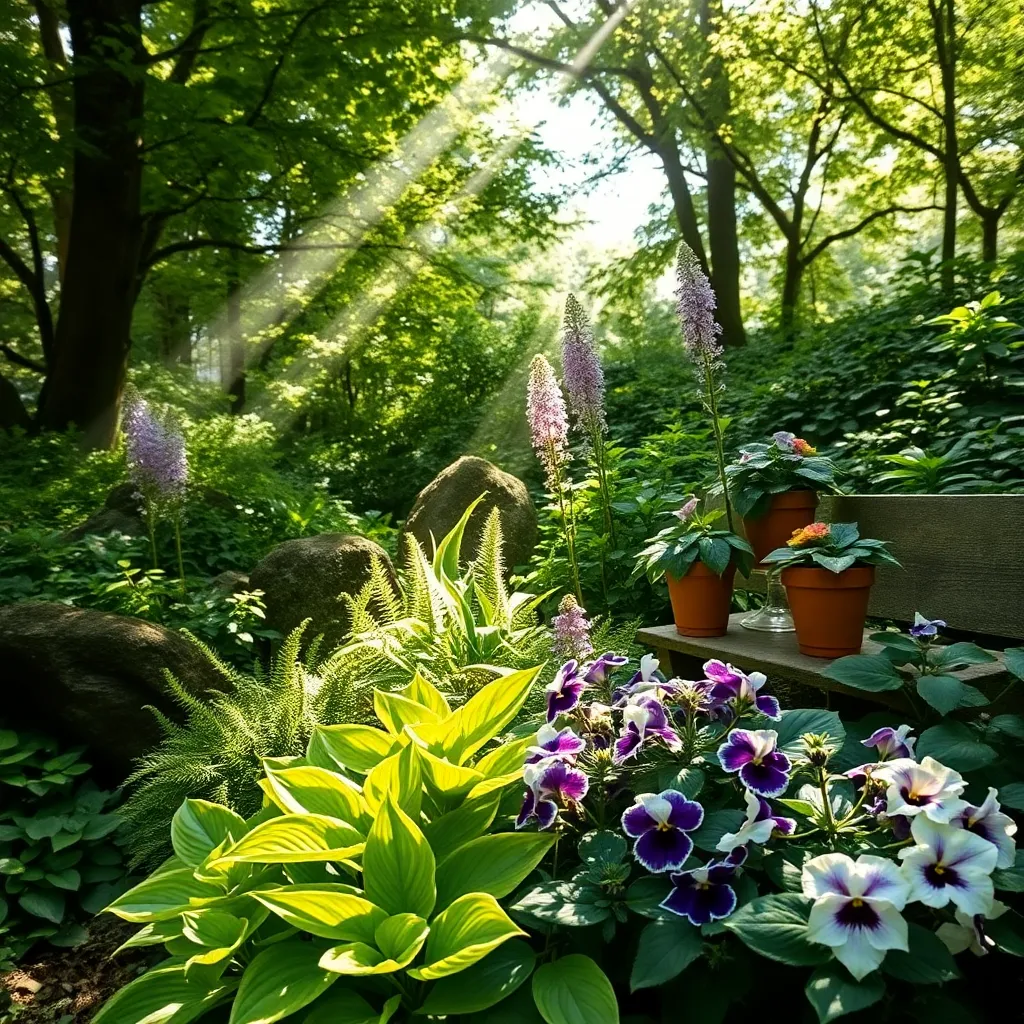
When selecting shade-tolerant plants for your garden, it’s crucial to consider their adaptability to low-light conditions. Many plants thrive in partial or full shade, offering a lush and vibrant garden area even without direct sunlight.
Start with some reliable choices, like hostas and ferns, which are known for their resilience and beauty. Hostas, for example, are easy to grow and require minimal maintenance, making them perfect for beginners.
Consider the soil type in your shaded area, as this can impact plant health and growth. Most shade-loving plants prefer well-drained soil rich in organic matter, so amend your soil with compost or well-rotted manure for optimal results.
Watering requirements for shade-tolerant plants can differ significantly from those in sunny spots. It’s essential to keep the soil consistently moist but not waterlogged, ensuring plants receive adequate hydration without drowning their roots.
- Use mulch to retain moisture and regulate soil temperature.
- Check soil moisture regularly—plants in shade may require less frequent watering than those in full sun.
For more advanced gardeners, experimenting with layering different plant heights can add depth and interest to a shaded area. Consider incorporating taller shrubs or small trees like Japanese maples, which can create a canopy effect and enhance the garden’s structure.
Hostas: The Shade Garden Staple

Hostas, known for their lush foliage, are a quintessential choice for any shade garden. These hardy perennials thrive in partial to full shade, making them perfect for areas under trees or beside north-facing walls.
When planting hostas, ensure the soil is well-draining and rich in organic matter. Amend heavy clay soils with compost to improve drainage and aeration, as hostas prefer moist but not waterlogged conditions.
Water hostas deeply once a week, especially during dry spells, to maintain their vibrant foliage. Avoid overhead watering to minimize the risk of fungal diseases, which can be common in shady, damp environments.
For the best growth, fertilize hostas in early spring with a balanced, slow-release fertilizer. Advanced gardeners may consider dividing hostas every three to five years to prevent overcrowding and maintain plant health.
Ferns for Lush Greenery
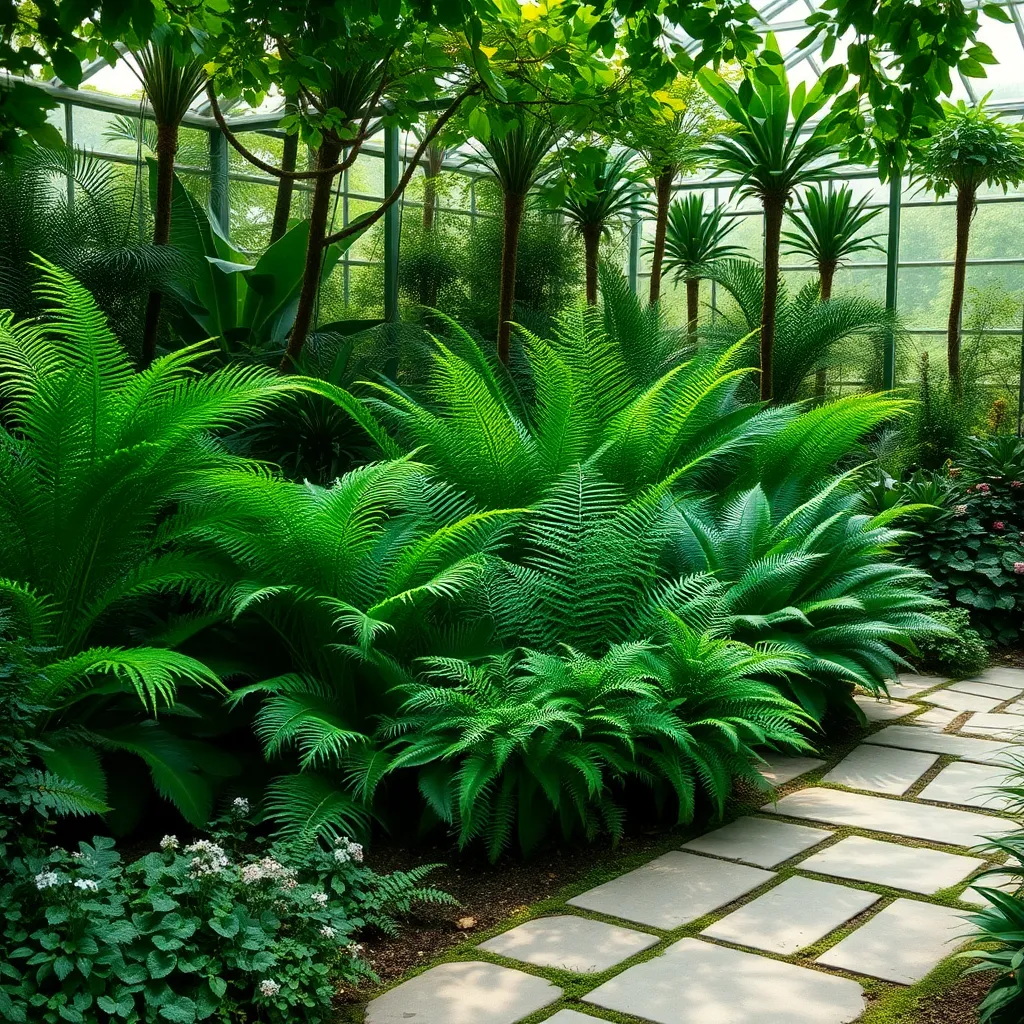
Ferns bring lush greenery to any shade garden, providing texture and depth that can enhance your outdoor space. They thrive in low light and high humidity conditions, making them perfect companions for other shade-loving plants like hostas.
To ensure your ferns thrive, plant them in well-draining soil that retains moisture but doesn’t become waterlogged. Adding organic matter like compost or peat moss can greatly improve the soil structure and provide essential nutrients.
Consistent watering is crucial for ferns, especially during dry spells. Aim to keep the soil consistently moist but avoid overwatering, as this can lead to root rot.
For those looking to expand their fern collection, consider propagating them through division in early spring. Simply dig up a mature fern and separate the root ball into smaller sections, ensuring each section has a healthy root system before replanting.
Astilbe: Colorful Shade Blossoms
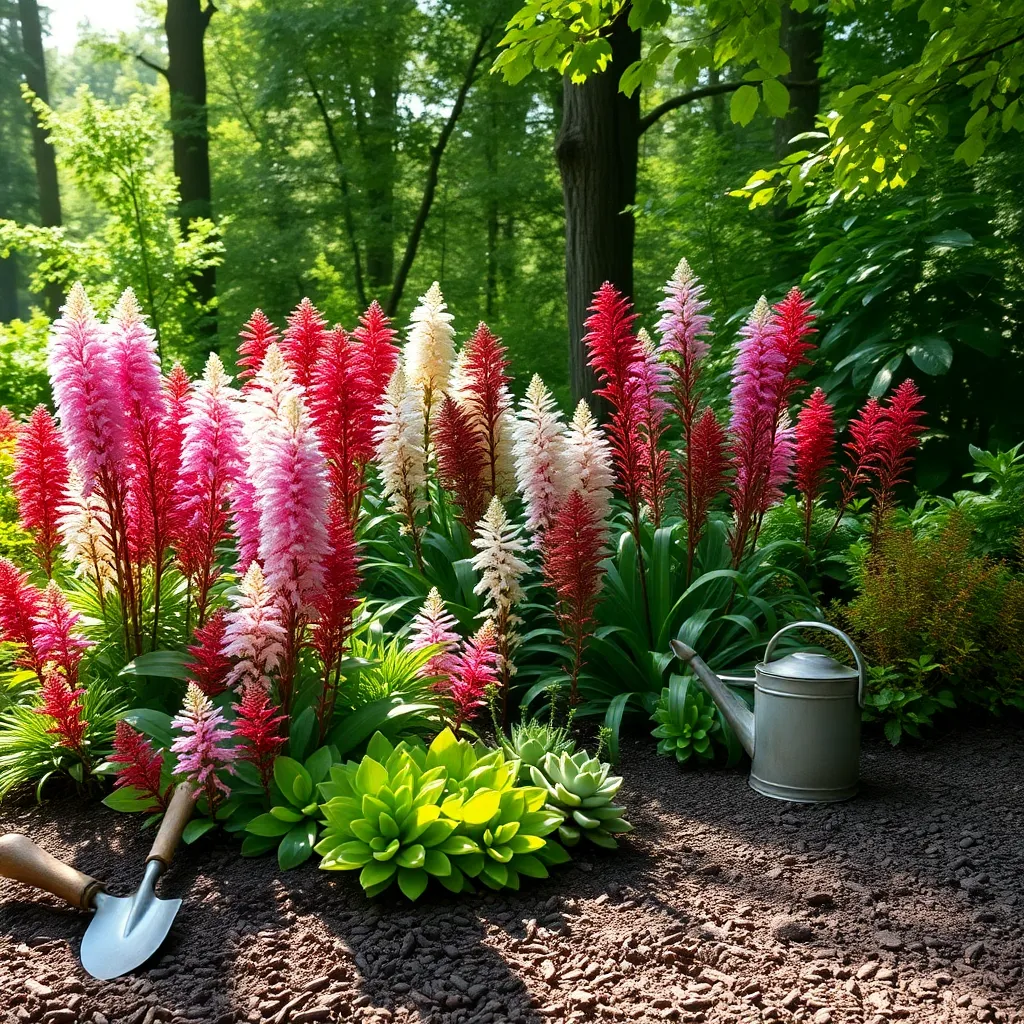
Astilbe is a fantastic choice for adding vibrant color to shaded garden areas. Known for their feathery plumes, these perennials thrive in partial to full shade, making them perfect companions for ferns and hostas.
To keep Astilbe flourishing, plant them in moist, well-drained soil enriched with organic matter. Regular watering is crucial, especially during dry spells, as Astilbe prefers consistently moist conditions.
For beginners, start with popular varieties like ‘Fanal’ or ‘Bridal Veil’, which are known for their resilience and stunning blooms. Advanced gardeners might experiment with different cultivars to extend the blooming period throughout the summer.
Fertilize your Astilbe in early spring with a balanced, slow-release fertilizer to promote lush growth. Mulching with organic material such as shredded bark can help retain soil moisture and suppress weeds, enhancing the plant’s overall health.
Heuchera: Foliage with Flair
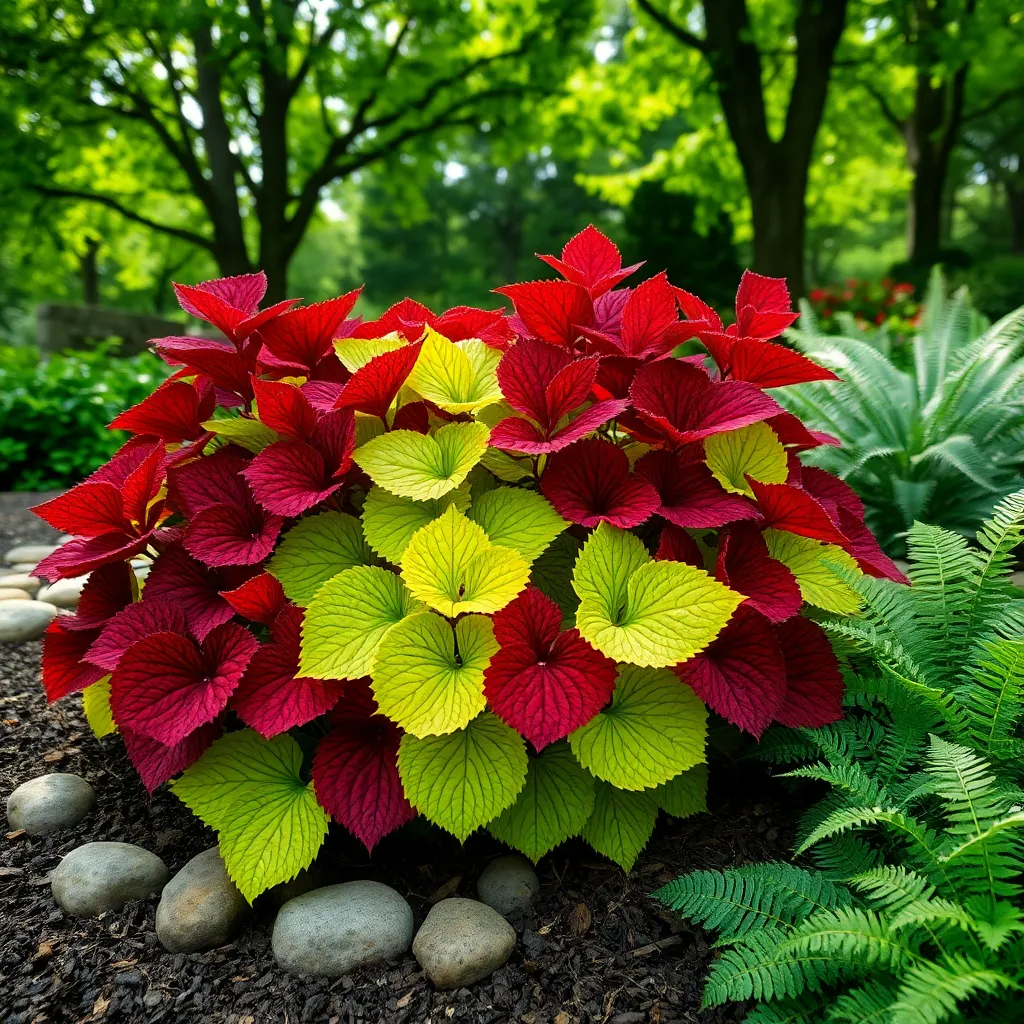
Heuchera, commonly known as coral bells, offers a stunning array of foliage colors, making it a perfect choice for adding flair to your shade garden. These perennials thrive in partial to full shade and can adapt to a range of soil types, though they prefer well-drained soil enriched with organic matter.
To keep Heuchera looking its best, water the plants consistently, ensuring the soil remains moist but not waterlogged. It’s important to mulch around the base to retain moisture and regulate soil temperature, which is particularly beneficial in warmer climates.
While Heuchera is generally low-maintenance, occasional fertilization can enhance its vigor. Apply a balanced, slow-release fertilizer in early spring to encourage robust growth and vibrant coloration.
For gardeners seeking to propagate Heuchera, dividing the plants every three to four years will help maintain their health and encourage new growth. Be sure to replant divisions at the same depth as the original plant to prevent crown rot.
Bleeding Heart: A Romantic Touch

Adding a Bleeding Heart to your shade garden can infuse it with a romantic and whimsical charm. Known for its heart-shaped blooms that dangle like pendants, this perennial thrives in cool, shady areas and is perfect for creating a serene garden oasis.
To cultivate a healthy Bleeding Heart, plant it in rich, well-drained soil that retains moisture but doesn’t become waterlogged. Regular watering is essential, especially during dry spells, to keep the soil consistently moist and support its lush foliage.
When planting, ensure you space the Bleeding Heart about 18 inches apart to allow for adequate air circulation and growth. This plant prefers a location with partial to full shade, making it an excellent choice for those tricky areas where sunlight is sparse.
For gardeners looking to extend the blooming season, consider deadheading spent flowers to encourage reblooming. Additionally, fertilize in early spring with a balanced fertilizer to boost its growth and vibrant blooms, ensuring your garden remains a romantic retreat throughout the season.
Japanese Forest Grass Elegance
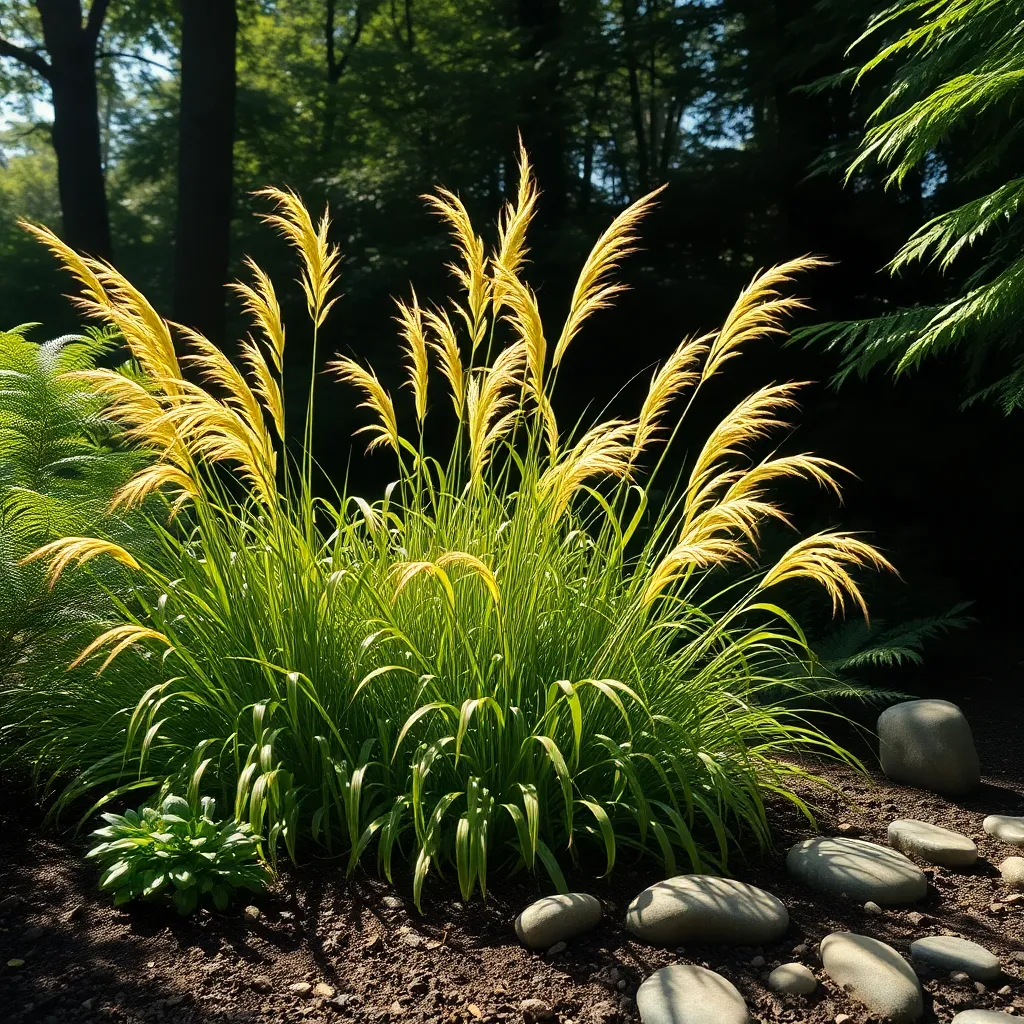
Japanese Forest Grass, also known as Hakonechloa, brings a touch of elegance to any shade garden with its graceful, arching blades. This perennial thrives in partial to full shade and is perfect for adding texture and movement to your garden design.
When planting Japanese Forest Grass, ensure the soil is rich in organic matter and well-drained, as this plant prefers moist conditions. For best results, incorporate compost or aged manure into the planting area to maintain soil fertility and structure.
Watering consistently is key to keeping this plant lush and healthy, especially during dry spells. Aim to keep the soil evenly moist but not soggy, and consider using a layer of mulch to retain moisture and suppress weeds.
For gardeners looking to add visual interest, Japanese Forest Grass offers several cultivars with varied leaf colors, such as golden or variegated options. More advanced gardeners might experiment with dividing clumps in early spring to propagate and expand their collection.
Coral Bells for Color Variety
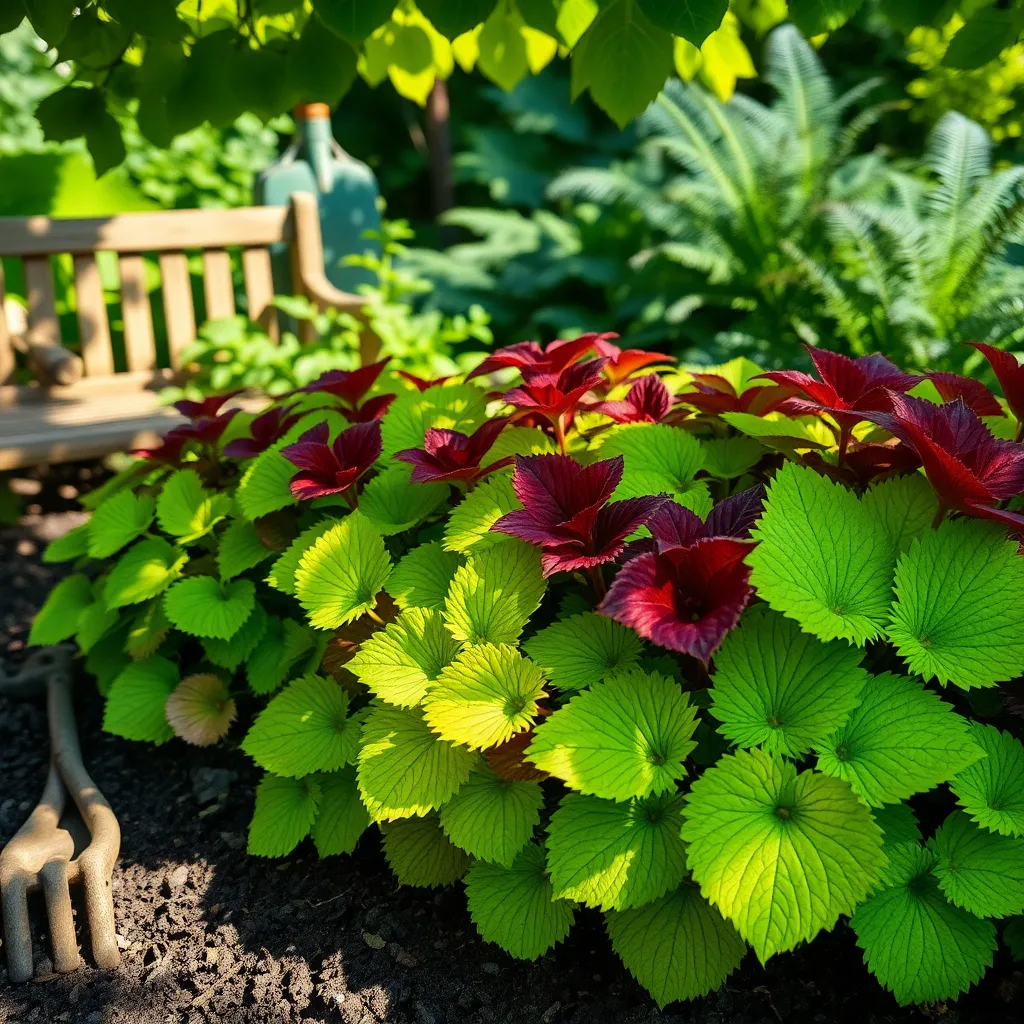
Coral Bells, also known as Heuchera, bring a vibrant splash of color to any shade garden with their striking foliage. These perennials are valued not just for their beautiful leaves but also for their delicate, bell-shaped flowers that bloom in late spring or early summer.
For optimal growth, plant Coral Bells in a location that receives morning sun and afternoon shade. They thrive in well-draining soil with a slightly acidic to neutral pH, so consider amending your soil with organic matter if needed.
Watering is crucial during the first growing season to establish a deep, extensive root system. Once established, Coral Bells are relatively drought-tolerant, but they do best with consistent moisture—aim to keep the soil evenly moist but not waterlogged.
To maintain their vibrant foliage, apply a layer of mulch around the base of the plants to conserve moisture and prevent weeds. For advanced gardeners, consider dividing the plants every 3 to 4 years in early spring to rejuvenate them and encourage more vigorous growth.
Brunnera: The Heartleaf Beauty
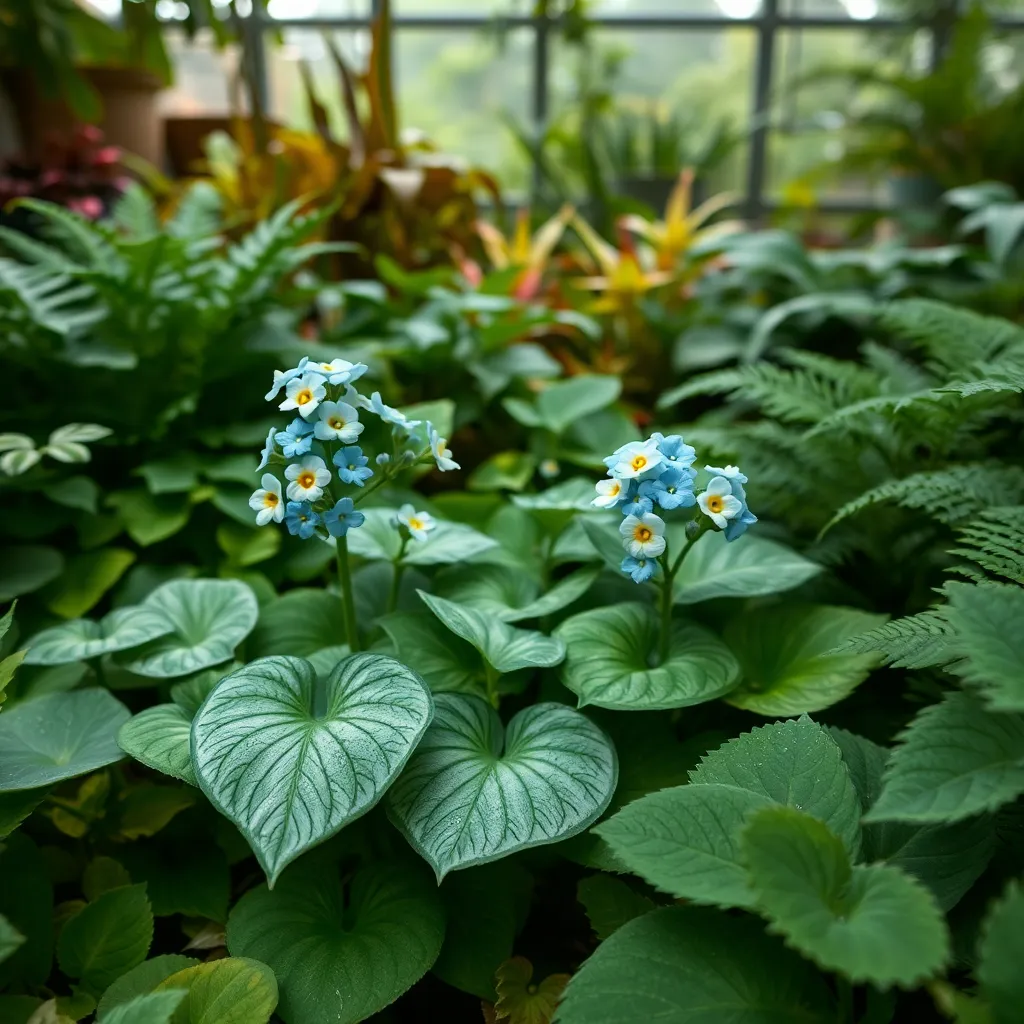
Brunnera, often referred to as the “Heartleaf Beauty,” is a captivating addition to any shade garden. Its heart-shaped leaves and delicate blue flowers provide a charming contrast to darker shaded areas.
For optimal growth, plant Brunnera in a location with partial to full shade, as too much sun can scorch its leaves. It thrives in moist, well-drained soil, so consider enriching your garden bed with compost to enhance nutrient retention.
Watering should be consistent but not excessive, with the goal of keeping the soil evenly moist. During dry spells, a deep watering once a week will help maintain the plant’s vibrant appearance.
For those looking to propagate this beauty, divide Brunnera clumps every few years in early spring. This not only rejuvenates the plant but also provides a perfect opportunity to expand your shade garden with new plantings.
Lungwort: Unique Blooms and Foliage

Lungwort, known for its striking foliage and charming blooms, thrives in shady garden spots. Its leaves are often speckled with white or silver, providing a visually appealing contrast to its colorful flowers.
This plant is a resilient choice for gardeners seeking low-maintenance options. Ensure the soil is well-draining and rich in organic matter to support Lungwort’s growth and prevent root rot.
Water regularly to maintain consistent moisture, but avoid waterlogging the roots. Applying a mulch layer can help retain soil moisture and keep the roots cool, especially during warmer months.
For those looking to propagate Lungwort, division in early spring or fall is the best method. Advanced gardeners can experiment with collecting seeds, but note that the plant may not breed true from seed.
Creating Year-Round Interest
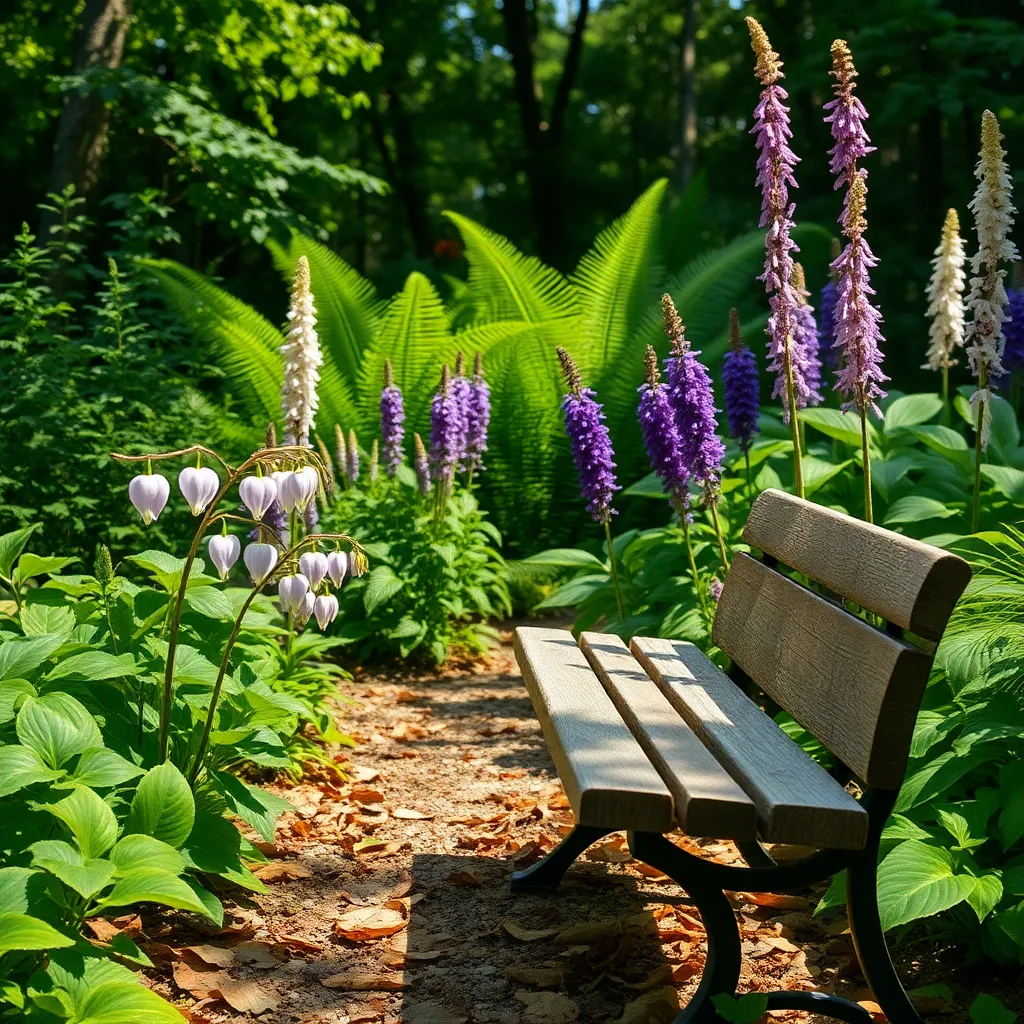
To create a shade garden that offers interest year-round, consider plants that provide more than just spring blooms. Incorporating plants with diverse textures, colors, and seasonal characteristics can ensure your garden remains captivating in every season.
Start by selecting plants with evergreen foliage, such as ferns or hostas, to maintain a lush appearance even in the dead of winter. These plants not only survive the colder months but also provide a consistent backdrop for other seasonal highlights.
Add variety by including plants with winter interest like hellebores, which bloom when most other plants are dormant. Their flowers emerge in late winter, offering a much-needed splash of color and a source of nectar for early pollinators.
Focus on layering your plants to create depth and interest. Use taller shrubs like azaleas at the back of your garden bed, and place lower-growing plants such as lungwort or brunnera in the foreground for a tiered effect.
To enhance the aesthetic appeal, choose plants with varying leaf shapes and colors. For example, mix the broad leaves of bergenia with the fine-textured foliage of Japanese forest grass to create a dynamic visual contrast.
Finally, ensure your soil is well-prepared by enriching it with organic matter like compost, which improves drainage and provides essential nutrients. Regular mulching can also help retain moisture and suppress weeds, contributing to a healthier, more vibrant shade garden.
Conclusion: Growing Success with These Plants
As we explored the diverse palette of “12 Creative Shade Garden Plants,” we uncovered key relationship concepts that mirror the nurturing required in both gardening and personal connections. Just like choosing the right plants for shaded areas, selecting the right elements—communication, trust, empathy, and adaptability, to name a few—is crucial in cultivating thriving relationships. We also touched on the importance of patience, active listening, and mutual respect as foundational elements that allow relationships to flourish, even in challenging conditions.
Now, take a moment to reflect on one relationship in your life. Identify a concept from the list and consider how you might apply it to strengthen your bond. Perhaps it’s initiating a heartfelt conversation or demonstrating appreciation more often.
I encourage you to bookmark this article as a handy guide for nurturing your relationships, just as you would return to a gardening manual for tips on sustaining your plants. Remember, successful relationships, like successful gardens, are not built overnight but are the result of consistent care and attention. Embrace these insights, and watch your personal connections grow more vibrant and robust with time. Together, let’s cultivate relationships that withstand the test of time and bloom beautifully in every season.

